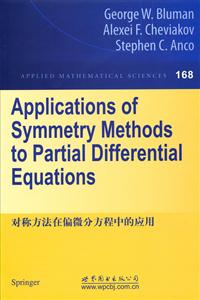|
对称方法在偏微分方程中的应用 内容简介
This book is a sequel to Symmetries and Integration Methods (2002), by George W. Bluman and Stephen C. Anco. It includes a significant update of the material in the last three chapters of Symmet'ries an,d Dzjjerential Equa-tions (1989; reprinted with corrections, 1996), by George W. Bluman and Sukeyuki Kumei. The emphasis in the present book is on how to find sys-tematically symmetries (local and nonlocal) and conservation laws (local and nonlocal) of a given PDE system and how to use systematically symmetries and conservation laws for related applications. In particular, for a given PDE system, it is shown how systematically (1) to find higher-order and nonlocal symmetries of the system; (2) to construct by direct methods its conserva- tion laws through finding sets of conservation law multipliers and formulas to obtain the fluxes of a conservation law from a known set of multipliers; (3) to determine whether it has a linearization by an invertible mapping and con- struct such a linearization when one exists from knowledge of its symmetries andlor conservation law multipliers, in the case wheii the given PDE system is nonlinear; (4) to use conservation laws to construct equivalent nonlocally related systems; (5) to use such nonlocally related systems to obtain nonlo- cal symmetries, nonlocal conservation laws and non-invertible mappings to linear systems; and (6) to construct specific solutions from reductions arising from its symmetries as well as from extensions of symmetry methods to find such reductions. This book is aimed at applied mathematicians; scientists and engineers interested in finding solutions of partial differential equations and is written in the style of the above-mentioned 1989 book by Bluman and Kumei. There are numerous examples involving various well-known physical and engineering PDE systems.
对称方法在偏微分方程中的应用 目录
Preface
Introduction
1 Local Transformations and Conservation Laws
1.1 Introduction
1.2 Local Transformations
1.2.1 Point transformations
1.2.2 Contact transformations
1.2.3 Higher-order transformations
1.2.4 One-parameter higher-order transformations
1.2.5 Point symmetries
1.2.6 Contact and higher-order symmetries
1.2.7 Equivalence transformations and symmetry classification
1.2.8 Recursion operators for local symmetries
1.3 Conservation Laws
1.3.1 Local conservation laws
1.3.2 Equivalent conservation laws
1.3.3 Multipliers for conservation laws.Euler operators
1.3.4 The direct method for construction of conservation laws.Cauchy-Kovalevskaya form
1.3.5 Examples
1.3.6 Linearizing operators and adjoint equations
1.3.7 Determination of fluxes of conservation laws from multipliers
1.3.8 Self-adjoint PDE systems
1.4 Noether's Theorem
1.4.1 Euler-Lagrange equations
1.4.2 Noether's formulation of Noether's theorem
1.4.3 Boyer's formulation of Noether's theorem
1.4.4 Limitations of Noether's theorem
1.4.5 Examples
1.5 Some Connections Between Symmetries and Conservation Laws
1.5.1 Use of symmetries to find new conservation laws from known conservation laws
1.5.2 Relationships among symmetries,solutions of adjoint equations,and conservation laws
1.6 Discussion
2 Construction of Mappings Relating Differential Equations
2.1 Introduction
2.2 Notations; Mappings of Infinitesimal Generators
2.2.1 Theorems on invertible mappings
2.3 Mapping of a Given PDE to a Specific Target PDE
2.3.1 Construction of non-invertible mappings
2.3.2 Construction of an invertible mapping by a point transformation
2.4 Invertible Mappings of Nonlinear PDEs to Linear PDEs Through Symmetries
2.4.1 Invertible mappings of nonlinear PDE systems(with at least two dependent variables)to linear PDE systems
2.4.2 Invertible mappings of nonlinear PDE systems(with one dependent variable)to linear PDE systems
2.5 Invertible Mappings of Linear PDEs to Linear PDEs with Constant Coefficients
2.5.1 Examples of mapping variable coefficient linear PDEs to constant coefficient linear PDEs through invertible point transformations
2.5.2 Example of finding the most general mapping of a given constant coefficient linear PDE to some constant coefficient linear PDE
2.6 Invertible Mappings of Nonlinear PDEs to Linear PDEs Through Conservation Law Multipliers
2.6.1 Computational steps
2.6.2 Examples of linearizations of nonlinear PDEs through conservation law multipliers
2.7 Discussion
3 Nonlocally Related PDE Systems
3.1 Introduction
3.2 Nonlocally Related Potential Systems and Subsystems in Two Dimensions
3.2.1 Potential systems
3.2.2 Nonlocally related subsystems
3.3 Trees of Nonlocally Related PDE Systems
3.3.1 Basic procedure of tree construction
3.3.2 A tree for a nonlinear diffusion equation
3.3.3 A tree for planar gas dynamics(PGD)equations
3.4 Nonlocal Conservation Laws
3.4.1 Conservation laws arising from nonlocally related systems
3.4.2 Nonlocal conservation laws for diffusion-convection equations
3.4.3 Additional conservation laws of nonlinear telegraph equations
3.5 Extended Tree Construction Procedure
3.5.1 An extended tree construction procedure
3.5.2 An extended tree for a nonlinear diffusion equation
3.5.3 An extended tree for a nonlinear wave equation
3.5.4 An extended tree for the planar gas dynamics equations
3.6 Discussion
4 Applications of Nonlocally Related PDE Systems
4.1 Introduction
4.2 Nonlocal Symmetries
4.2.1 Nonlocal symmetries of a nonlinear diffusion equation
4.2.2 NonlocAL symmetries of a nonlinear wave equation
4.2.3 Classification of nonlocal symmetries of nonlinear telegraph equations arising from point symmetries of potential systems
4.2.4 Nonlocal symmetries of nonlinear telegraph equations with power law nonlinearities
4.2.5 Nonlocal symmetries of the planar gas dynamics equations
4.3 Construction of Non-invertible Mappings Relating PDEs
4.3.1 Non-invertible mappings of nonlinear PDE systems to linear PDE systems
4.3.2 Non-invertible mappings of linear PDEs with variable coefficients to linear PDEs with constant coefficients.
4.4 Discussion
5 Further Applications of Symmetry Methods: Miscellaneous Extensions
5.1 Introduction
5.2 Applications of Symmetry Methods to the Construction of Solutions of PDEs
5.2.1 The classical method
5.2.2 The nonclassical method
5.2.3 Invariant solutions arising from nonlocal symmetries that are local symmetries of nonlocally related systems
5.2.4 Futrther extensions of symmetry methods for construction of solutions of PDEs connected with nonlocaUy related systems
5.3 Nonlocally Related PDE Systems in Three or More Dimensions
5.3.1 Divergence-type conservation laws and resulting potential systems
5.3.2 Nonlocally related subsystems
5.3.3 Tree construction,nonlocal conservation laws,and nonlocal symmetries
5.3.4 Lower-degree conservation laws and related potential systems
5.3.5 Examples of applications of nonlocally related systems in higher dimensions
5.3.6 Symmetries and exact solutions of the three-dimensional MHD equilibrium equations
5.4 Symbolic Software
5.4.1 An example of symbolic computation of point symmetries
5.4.2 An example of point symmetry classification
5.4.3 An example of symbolic computation of conservation laws
5.5 Discussion
References
Theorem,Corollary and Lemma Index
Author Index
Subject Index

|

